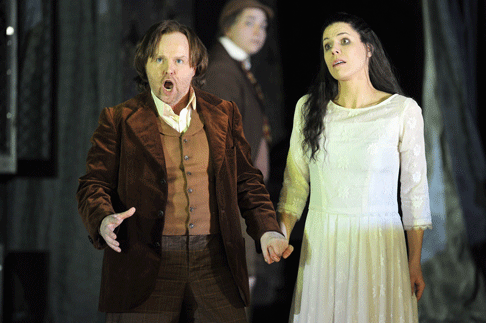An opÈra fantastique, with which Offenbach at the end
of his career wished to show the world that he was not a mere purveyor of
enjoyable froth, certainly offers plenty of opportunity for the
surreally-inclined. (Jones’s controversial 1990s Ring for the Royal Opera
House garnered plaudits and brickbats on that basis. Sadly, if not entirely
unpredictably, it proved not to be Bernard Haitink’s idea of a
Ring at all.) The pipe emblazoned upon the stage curtain and the pipes
being smoked by Hoffmann and the students seem to hold the key to the
director’s conception. Whatever it is that is being smoked would appear
to lie behind the visions. Fair enough, but there is perhaps a little too much
of the surface psychedelic, especially during the second (here, first) act, and
not enough truly Romantic, Gothic darkness. We are dealing with Offenbach
rather than Hoffmann himself, of course, but it would be beneficial to see, if
not to hear, a little more of the hero, a still grossly underappreciated figure
in the English-speaking world. (One really needs German.) Some of what we see
resembles a little too closely Jones’s Covent Garden productions of
Gianni
Schicchi and The
Gambler. Difficult though it may be to feel sympathy for the 1950s, a
decade of closed-mindedness if every there were one, is it always necessary to
send them up so garishly as in the Olympia act? (At least I assume that was
what was being attempted.) Why a gorilla was wandering around the stage before
and during the fourth (here, third) act, I simply have no idea. Its inclusion
seemed to add nothing beyond reminding us of the mÈnagerie in that splendid
production of The Gambler. The appearance of Dr Miracle as Antonia
opens her music is very nicely handled, though, likewise the appearance of her
mother’s voice through a gramophone trumpet. It is, then, an enjoyable
production; costumes, movement, and lighting are all well handled in the
production’s own terms. The same basic set is varied imaginatively
between acts, providing a finer sense of overall framing than the production as
a whole. I just could not help but think that Offenbach’s desire to be
taken seriously might have been taken a little more seriously.
From the singers, there was much to enjoy. Barry Banks sang a decent enough
English-language Hoffmann, though his style was more Italianate, occasionally
jarringly so, than Gallic. If there was not an especially strong sense of
Hoffmann as artist, especially at the end, then that was at least as much down
to production as performance. Christine Rice, however, made a fine Nicklausse.
(She also appeared as Hoffmann’s Muse, that doubling respecting
Offenbach’s original intention.) Again, one could not help but wish that
the words were in French, but Rice’s palpable sincerity won through time
and time again, ‘Vois sous l’archet frÈmissant’ – I cannot
recall what the English was – a particular, soaring highlight. Georgia
Jarman, making her ENO debut, truly impressed by taking on all four of
Hoffmann’s lovers: Stella, Olympia, Antonia, and Giulietta. Her
characterisation varied, bringing something quite new to each of them.
Antonia’s fate was rendered as moving as the production – and the
music – would allow; Giulietta proved properly seductive; and save for a
few slight intonational problems at the very beginning, Olympia’s
mechanical coloratura was despatched with great aplomb. Catherine Young’s
off-stage turn as the Mother’s Voice (a ghost, traditionally) was
beautifully performed. Mention must also be made of Simon Butteriss, kept busy
with four different roles: AndrËs, Cochenille, Frantz, and Pitichinaccio.
Clearly at home in drag as Cochenille, he also provided a wickedly camp turn as
the servant Frantz.
 Barry Banks and Georgia Jarman
Barry Banks and Georgia Jarman
The ENO orchestra once again proved to be on fine form, though Antony
Walker’s direction was less sure-footed. Here, at least, one might have
hoped for a little more Gallic suavity; there were times when his approach
veered a little close to thinned-down Tchaikovsky (less a point of view, it
seemed, than a lack of idiomatic command). Given that the work was performed in
English, spoken dialogue might have been a better bet than recitative.
Amplification of the chorus at the end was surely both unnecessary and oddly
sentimentalising, as if we had come to the end of a Hollywood ‘Romantic
comedy’. Again, Offenbach’s desire to be taken seriously might have
been taken more seriously. The production is worth seeing, and the cast
certainly makes it worth hearing, but one would struggle to discern a message,
let alone a Konzept.
Mark Berry
image=http://www.operatoday.com/Georgia_Jarman3.gif
image_description=Georgia Jarman [Photo by Chris Christodoulou courtresy of English National Opera]
product=yes
product_title=Jacques Offenbach: The Tales of Hoffmann
product_by=Hoffmann: Barry Banks; Stella, Olympia, Antonia, Giulietta: Georgia Jarman; Muse, Nicklausse: Christine Rice; Counsellor Lindorf, CoppÈlius, Dr Miracle, Captain Dapertutto: Clive Bayley; Spalanzani: Iain Paton; Crespel, Luther: Graeme Danby; AndrËs, Cochenille, Frantz, Pitchinaccio: Simon Butteriss; Voice of Antonia’s mother: Catherine Young; SchlÈmil: Tom Fackrell; Students: Richard Gerard Jones, Luke Owens, Sebastian Sykes. Director: Richard Jones; Set Designer: Giles Cadle; Costumes: Buki Schiff; Lighting: Mimi Jordan Sherin; Movement: Lucy Burge. Chorus of the English National Opera (chorus master: Francine Merry); Orchestra of the English National Opera/ Antony Walker (conductor). Coliseum, London, Friday 10 February 2012.
product_id=Above: Georgia Jarman
Photos by Chris Christodoulou courtesy of English National Opera